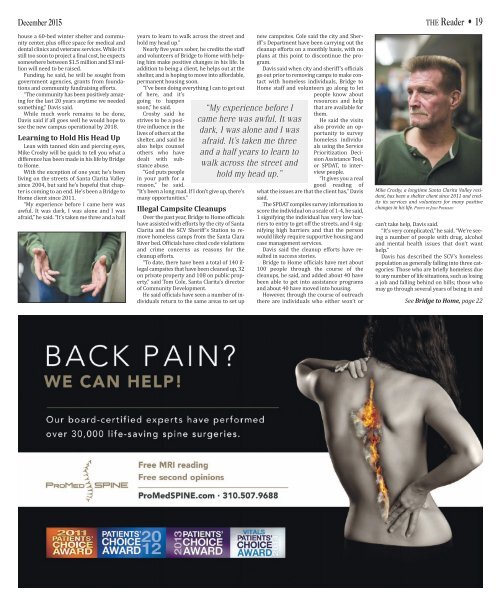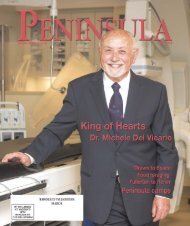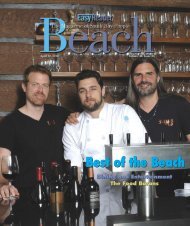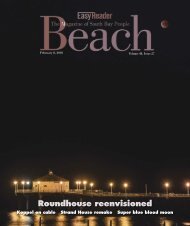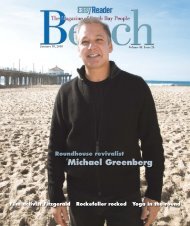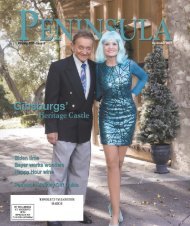Create successful ePaper yourself
Turn your PDF publications into a flip-book with our unique Google optimized e-Paper software.
<strong>December</strong> <strong>2015</strong> THE <strong>Reader</strong> • 19<br />
house a 60-bed winter shelter and community<br />
center, plus office space for medical and<br />
dental clinics and veterans services. While it’s<br />
still too soon to project a final cost, he expects<br />
somewhere between $1.5 million and $3 million<br />
will need to be raised.<br />
Funding, he said, he will be sought from<br />
government agencies, grants from foundations<br />
and community fundraising efforts.<br />
“The community has been positively amazing<br />
for the last 20 years anytime we needed<br />
something,” Davis said.<br />
While much work remains to be done,<br />
Davis said if all goes well he would hope to<br />
see the new campus operational by 2018.<br />
Learning to Hold His Head Up<br />
Lean with tanned skin and piercing eyes,<br />
Mike Crosby will be quick to tell you what a<br />
difference has been made in his life by Bridge<br />
to Home.<br />
With the exception of one year, he’s been<br />
living on the streets of Santa Clarita Valley<br />
since 2004, but said he’s hopeful that chapter<br />
is coming to an end. He’s been a Bridge to<br />
Home client since 2011.<br />
“My experience before I came here was<br />
awful. It was dark, I was alone and I was<br />
afraid,” he said. “It’s taken me three and a half<br />
years to learn to walk across the street and<br />
hold my head up.”<br />
Nearly five years sober, he credits the staff<br />
and volunteers of Bridge to Home with helping<br />
him make positive changes in his life. In<br />
addition to being a client, he helps out at the<br />
shelter, and is hoping to move into affordable,<br />
permanent housing soon.<br />
“I’ve been doing everything I can to get out<br />
of here, and it’s<br />
going to happen<br />
soon,” he said.<br />
Crosby said he<br />
strives to be a positive<br />
influence in the<br />
lives of others at the<br />
shelter, and said he<br />
also helps counsel<br />
others who have<br />
dealt with substance<br />
abuse.<br />
“God puts people<br />
in your path for a<br />
reason,” he said.<br />
“It’s been a long road. If I don’t give up, there’s<br />
many opportunities.”<br />
Illegal Campsite Cleanups<br />
Over the past year, Bridge to Home officials<br />
have assisted with efforts by the city of Santa<br />
Clarita and the SCV Sheriff’s Station to remove<br />
homeless camps from the Santa Clara<br />
River bed. Officials have cited code violations<br />
and crime concerns as reasons for the<br />
cleanup efforts.<br />
“To date, there have been a total of 140 illegal<br />
campsites that have been cleaned up, 32<br />
on private property and 108 on public property,”<br />
said Tom Cole, Santa Clarita’s director<br />
of Community Development.<br />
He said officials have seen a number of individuals<br />
return to the same areas to set up<br />
“My experience before I<br />
came here was awful. It was<br />
dark, I was alone and I was<br />
afraid. It’s taken me three<br />
and a half years to learn to<br />
walk across the street and<br />
hold my head up.”<br />
new campsites. Cole said the city and Sheriff’s<br />
Department have been carrying out the<br />
cleanup efforts on a monthly basis, with no<br />
plans at this point to discontinue the program.<br />
Davis said when city and sheriff’s officials<br />
go out prior to removing camps to make contact<br />
with homeless individuals, Bridge to<br />
Home staff and volunteers go along to let<br />
people know about<br />
resources and help<br />
that are available for<br />
them.<br />
He said the visits<br />
also provide an opportunity<br />
to survey<br />
homeless individuals<br />
using the Service<br />
Prioritization Decision<br />
Assistance Tool,<br />
or SPDAT, to interview<br />
people.<br />
“It gives you a real<br />
good reading of<br />
what the issues are that the client has,” Davis<br />
said.<br />
The SPDAT compiles survey information to<br />
score the individual on a scale of 1-4, he said,<br />
1 signifying the individual has very low barriers<br />
to entry to get off the streets, and 4 signifying<br />
high barriers and that the person<br />
would likely require supportive housing and<br />
case management services.<br />
Davis said the cleanup efforts have resulted<br />
in success stories.<br />
Bridge to Home officials have met about<br />
100 people through the course of the<br />
cleanups, he said, and added about 40 have<br />
been able to get into assistance programs<br />
and about 40 have moved into housing.<br />
However, through the course of outreach<br />
there are individuals who either won’t or<br />
Mike Crosby, a longtime Santa Clarita Valley resident,<br />
has been a shelter client since 2011 and credits<br />
its services and volunteers for many positive<br />
changes in his life. phoTo By JoSh pReMAko<br />
can’t take help, Davis said.<br />
“It’s very complicated,” he said. “We’re seeing<br />
a number of people with drug, alcohol<br />
and mental health issues that don’t want<br />
help.”<br />
Davis has described the SCV’s homeless<br />
population as generally falling into three categories:<br />
Those who are briefly homeless due<br />
to any number of life situations, such as losing<br />
a job and falling behind on bills; those who<br />
may go through several years of being in and<br />
See Bridge to Home, page 22


